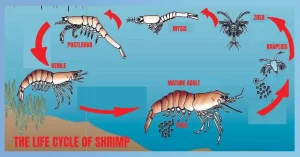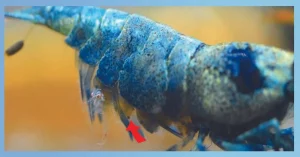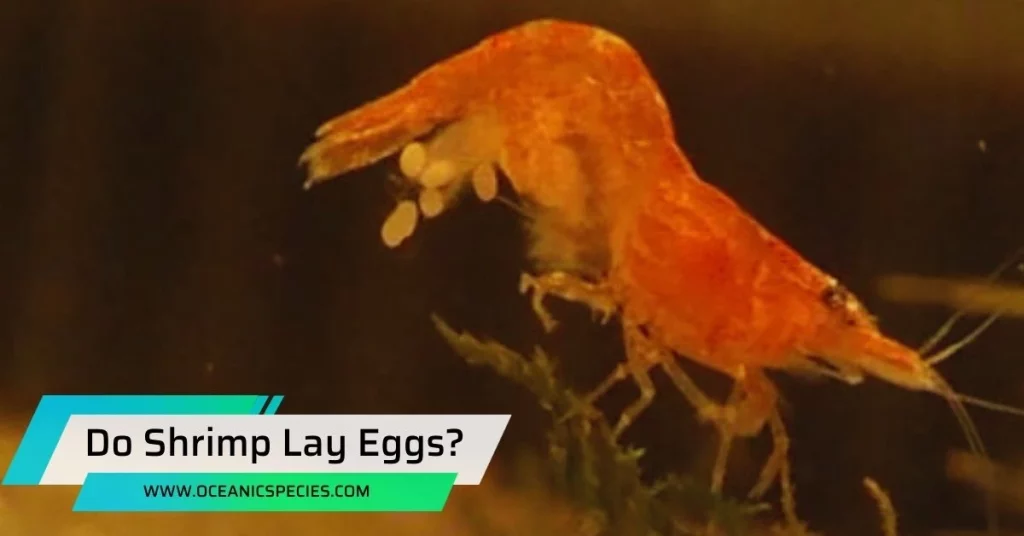Do Shrimp Lay Eggs? Discover the Fascinating Shrimp Reproduction Process
Shrimp lay eggs, which they carry underneath their bodies for about 30 days until the eggs hatch into baby shrimp. During this time, the female shrimp will move and fan the eggs to keep them clean and oxygenated.
It is important to protect the eggs and newborn shrimp from predators in the tank. Shrimp, like many other aquatic creatures, have a fascinating reproductive process. While some animals give live birth, shrimp lay eggs.
We will explore the intriguing world of shrimp reproduction, focusing on the question of whether shrimp lay eggs and how they care for their eggs.
Shrimp Reproduction: An Intriguing Cycle Of Life
Shrimp reproduction is an intriguing cycle of life, as females carry eggs underneath them for about 30 days, ensuring their safety and oxygenation. Cherry shrimp, in particular, give birth to live shrimplets, which can be seen under the females’ bellies.
Overview Of Shrimp Reproduction:
Shrimp reproduction is a fascinating process that involves intricate stages and behaviors. Shrimp are known for their ability to lay eggs and undergo a reproductive cycle that ensures the survival of their species. Understanding the life cycle of shrimp and their reproductive habits can provide valuable insights into these intriguing creatures.
The Life Cycle Of Shrimp:
Shrimp start their life as tiny larvae that hatch from eggs laid by adult females. The larvae go through several molting stages, shedding their exoskeletons to grow larger.

As they mature, they develop into juvenile shrimp, eventually reaching adulthood. Male and female adults mate, with the female carrying the fertilized eggs under her abdomen.
The female shrimp diligently fans and moves the eggs to keep them clean and oxygenated. After approximately 30 days, the eggs hatch, giving rise to tiny baby shrimp that closely resemble their adult counterparts.
It is crucial to create a predator-free environment for the newborn shrimp, as they are vulnerable to predation. The cycle repeats as adult shrimp continue to reproduce, ensuring the continuation of their species.
The Incredible Journey Of Shrimp Reproduction
Shrimp reproduction involves the female carrying eggs underneath her for about 30 days. Once hatched, baby shrimp are miniature versions of the adults. Predators should be avoided to protect the newborn shrimp. Keep in mind that cherry shrimp give live birth, with the females getting ‘berried’ with shrimplet eggs.
Spawning: The Beginning Of An Amazing Process
During spawning, female and male shrimp release their reproductive cells into the water. This typically occurs in the spring or summer when the conditions are ideal for reproduction. Here are a few key points about spawning:
- Spawning is triggered by environmental factors such as temperature, sunlight, and water quality.
- Female shrimp release pheromones that attract male shrimp to facilitate mating.
- Once the male and female shrimp mate, the female carries the eggs until they are ready to hatch.
Fertilization: Where Life Begins
Fertilization is a crucial step in the shrimp reproduction process. It is the moment when the male shrimp’s sperm fertilizes the female’s eggs. Here are some important points to note about fertilization:
- Once the male shrimp releases sperm into the water, the female shrimp collects it and uses it to fertilize her eggs.
- The fertilization process can take place externally or internally, depending on the shrimp species.
- In some species, the female shrimp holds the fertilized eggs in a specialized pouch until they hatch.
The Role Of Eggs In Shrimp Reproduction
Eggs play a vital role in the reproduction of shrimp. They are where the life of the next generation begins. Here’s what you should know about the role of eggs:
- Female shrimp carry the fertilized eggs either externally or internally, depending on the species.
- External carrying involves attaching the eggs to the female’s swimmerets or pleopods, where they are protected until they hatch.
- Internal carrying occurs when the eggs are held in a specialized pouch on the female’s body until they are ready to hatch.
Nurturing The Next Generation: Shrimp Parenting
Shrimp parenting involves the female carrying eggs for about 30 days, carefully fanning and moving them to keep them clean and oxygenated. The newborn shrimp are miniature replicas of the adults, making them vulnerable to predators in the tank.
Egg Care: The Responsibilities of Shrimp Parents:
Shrimp parents take their role as egg guardians seriously, ensuring the survival of their offspring through meticulous care and protection. After female shrimp lay their eggs, they attach them to their pleopods, also known as swimmerets. This allows the eggs to receive vital oxygen and enables proper growth and development.
The female shrimp constantly fans her eggs with her pleopods, ensuring a continuous flow of oxygen and preventing fungal growth. This fanning action also helps to distribute any debris that may accumulate around the eggs, keeping them clean and healthy.
Shrimp parents are diligent in maintaining optimal water conditions for the eggs. They carefully remove any eggs that may become discolored, indicating a potential issue. The female shrimp will also consume any infertile or damaged eggs to prevent the spread of disease or infection to healthy eggs.
Protecting Shrimp Eggs: Strategies and Adaptations:
Shrimp have developed various strategies and adaptations to protect their eggs from predators and ensure their survival.

One such adaptation is the release of pheromones by female shrimp, which act as a warning signal to other shrimp that predators are nearby. This allows the shrimp to take evasive action and safeguard their eggs. Some shrimp species, such as the ghost shrimp, build burrows in the sand to protect their eggs from predators. The burrows provide a safe and secure environment where the eggs can develop without the risk of being consumed.
Another strategy employed by some shrimp species is carrying the eggs in a specialized pouch, called a marsupium, located on their abdomen. This pouch offers protection against predators and provides a constant flow of oxygen to the developing eggs.
Shrimp parents also display defensive behaviors, such as aggressive displays and territoriality, to deter potential threats and safeguard their offspring.
Development of Shrimp Embryos: A Marvel of Nature:
The development of shrimp embryos is a fascinating and intricate process that highlights the wonders of nature. After the eggs are laid, they undergo a series of developmental stages known as embryogenesis. During this process, the eggs transform into fully formed shrimp. The embryo begins as a single cell and undergoes cell division and differentiation, forming specialized tissues and organs.
Over time, the shrimp embryo develops appendages and starts to exhibit characteristic shrimp traits, such as the formation of eyes and legs. The process of embryogenesis is facilitated by the exchange of oxygen and nutrients between the egg and the external environment. This exchange occurs through the egg’s delicate membrane. As the embryos develop, they become more active, eventually hatching from the egg and entering the world as miniature versions of adult shrimp.
From Eggs To Hatchlings: Hatching And Early Development
Shrimp lay eggs, and once bred, the female carries the eggs underneath her for about 30 days. The eggs hatch into tiny baby shrimp, exact duplicates of the adults. It is important to ensure there are no predators in the tank to protect the newborn shrimp.
Hatching: The Remarkable Emergence Of Baby Shrimp
Shrimp eggs, also known as “spawn,” hatch into baby shrimp through a fascinating process called hatching. During hatching, the eggs undergo various changes until they eventually emerge as tiny shrimp.
Here are the key points to understand about the hatching phase:
- Shrimp eggs typically hatch within a few days to a few weeks, depending on the species and environmental conditions.
- The hatching process starts with the eggs absorbing water, causing them to swell.
- As the eggs swell, the outer shell begins to crack, allowing the baby shrimp to wriggle free.
- Once hatched, the baby shrimp are known as “larvae” and are ready to embark on their journey through the next phase of development.
Environmental Factors Affecting Shrimp Reproduction
Shrimp reproduction is influenced by various environmental factors. Female shrimp carry their eggs underneath their bodies for about 30 days, fanning and moving them to ensure cleanliness and oxygenation. It is important to protect newborn shrimp from predators in the tank.
Water Quality And Its Impact On Shrimp Eggs
Maintaining good water quality is crucial for the successful reproduction of shrimp. Here are some factors to consider:
- PH level: Shrimp eggs require a specific pH level, typically between 6.5 and 8. Low or high pH levels can negatively affect egg development and survival.
- Salinity: Shrimp eggs need the right salinity level to hatch and grow. Maintaining salinity within the optimal range is essential for successful reproduction.
- Dissolved oxygen: Sufficient oxygen levels are necessary for the survival and growth of shrimp eggs. Poor water circulation or low oxygen levels can lead to low hatching rates or even egg mortality.
- Ammonia and nitrate levels: High levels of ammonia and nitrate can be toxic to shrimp eggs, causing deformities or even death. Regular monitoring and maintaining appropriate levels are essential for successful reproduction.
Temperature And Its Influence On Shrimp Reproduction
Temperature plays a crucial role in shrimp reproduction. Here’s how it can affect the process:
- Optimal temperature range: Shrimp eggs require specific temperature conditions to develop and hatch successfully. Most species prefer temperatures between 75°F and 85°F (24°C – 29°C). Deviations from this range can significantly impact egg development and hatch rates.
- Temperature fluctuations: Rapid temperature changes or extreme temperature variations can disrupt the reproductive cycle of shrimp. It is essential to provide a stable and consistent temperature environment to ensure successful reproduction.
- Seasonal considerations: Shrimp species have different temperature preferences for reproduction. Understanding the natural seasonality of the species you are breeding can help mimic their preferred environmental conditions and enhance reproductive success.
Nutritional Requirements For Successful Shrimp Reproduction
Proper nutrition is vital for shrimp reproduction. Consider the following points:
- High-quality diet: Providing a well-balanced and nutrient-rich diet promotes successful reproduction. Shrimp require adequate protein, vitamins, and minerals to develop healthy eggs and support the growth of the larvae.
- Essential fatty acids: Shrimp need omega-3 and omega-6 fatty acids for reproductive processes. Including a food source rich in these fatty acids can improve reproductive performance.
- Vitamin supplementation: Some vitamins, such as vitamin E and B vitamins, play important roles in the reproductive process of shrimp. Providing a diet supplemented with these vitamins can enhance reproductive success.
- Feeding frequency: Regular and frequent feeding is crucial during the reproductive period. Ensuring an ample food supply helps sustain the energy levels needed for successful egg development and hatching.
Shrimp Reproduction In The Wild Versus Captivity
Shrimp in the wild carry eggs underneath their bodies for about 30 days, ensuring their cleanliness and oxygenation. These eggs eventually hatch into tiny shrimp. In captivity, cherry shrimp give live birth to shrimplets, with females carrying eggs under their bellies.
Shrimp Reproduction: Natural Vs. Artificial Conditions
Shrimp reproduction can occur both in the wild and in captivity. While the natural conditions allow shrimps to reproduce on their own, artificial conditions in captivity require human intervention to facilitate the process. Here’s a breakdown of shrimp reproduction in natural versus artificial conditions:
Challenges In Reproducing Shrimp In Captivity
Reproducing shrimp in captivity comes with its own set of challenges. Some of the main difficulties faced include:
- Limited space: Shrimp farms often have limited space for shrimp to breed and reproduce naturally, which can hinder their reproductive success.
- Water quality: Maintaining optimal water quality is crucial for successful shrimp reproduction. Poor water conditions can lead to stress and disease, affecting the reproductive ability of shrimp.
- Feeding: Providing the right nutrition and feeding practices is essential for the health and reproductive success of shrimp in captivity. A well-balanced diet promotes proper maturation and egg development.
Frequently Asked Questions
What Does Shrimp Eggs Look Like?
Shrimp eggs look like tiny, translucent spheres that are attached to the underside of the female shrimp.
How Long Do Shrimp Carry Eggs?
Once bred, female shrimp carry eggs for about 30 days, ensuring they are clean and oxygenated.
Do Cherry Shrimp Give Live Birth?
Cherry shrimp give birth to live shrimplets, and the females carry the eggs under their bellies.
How Do You Know When Shrimp Are Laying Eggs?
Shrimp lay eggs, which are carried by the female for about 30 days.
Conclusion
Shrimp are fascinating creatures, and one common question that arises is whether they lay eggs. The answer is yes, shrimp do lay eggs. Once bred, the female shrimp will carry the eggs underneath her body for about 30 days. During this time, she will fan and move them around to keep them clean and oxygenated.
Whether you are a shrimp enthusiast or simply curious about these intriguing crustaceans, understanding their egg-laying habits adds another dimension of knowledge and appreciation. So the next time you see shrimp in an aquarium or on a plate, you can marvel at the journey they have gone through, from tiny eggs to fully grown individuals.

